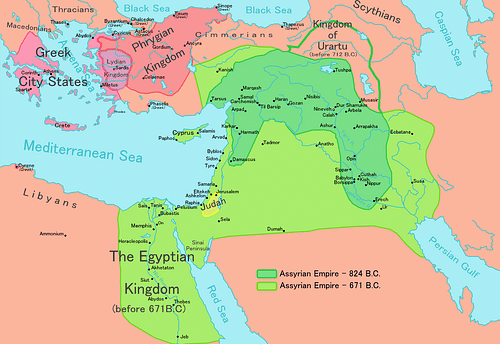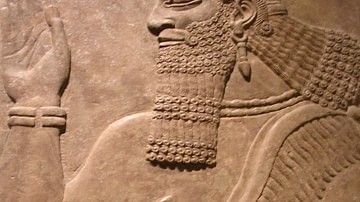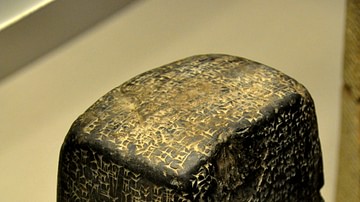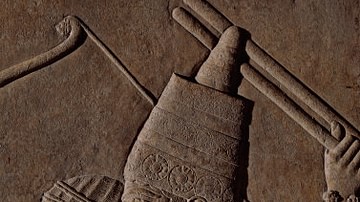
Assyria began as a small trading community centered at the ancient city of Ashur and grew to become the greatest empire in the ancient world prior to the conquests of Alexander the Great and, after him, the Roman Empire. While the Assyrians' administrative skills were impressive, and they could be adept at diplomacy when necessary, these were not the means by which the empire grew to rule the ancient world from Egypt in the south, through the Levant and Mesopotamia, and over to Asia Minor; it was their skill in warfare.
The Assyrian war machine was the most efficient military force in the ancient world up until the fall of the empire in 612 BCE. The secret to its success was a professionally trained standing army, iron weapons, advanced engineering skills, effective tactics, and, most importantly, a complete ruthlessness which came to characterize the Assyrians to their neighbors and subjects and still attaches itself to the reputation of Assyria in the modern day. A phrase oft-repeated by Assyrian kings in their inscriptions regarding military conquests is "I destroyed, devastated, and burned with fire" those cities, towns, and regions which resisted Assyrian rule.
The Assyrian kings were not to be trifled with and their inscriptions vividly depict the fate which was certain for those who defied them. The historian Simon Anglim writes:
The Assyrians created the world's first great army and the world's first great empire. This was held together by two factors: their superior abilities in siege warfare and their reliance on sheer, unadulterated terror. It was Assyrian policy always to demand that examples be made of those who resisted them; this included deportations of entire peoples and horrific physical punishments. One inscription from a temple in the city of Nimrod records the fate of the leaders of the city of Suru on the Euphrates River, who rebelled from, and were reconquered by, King Ashurbanipal:
I built a pillar at the city gate and I flayed all the chief men who had revolted and I covered the pillar with their skins; some I walled up inside the pillar, some I impaled upon the pillar on stakes." Such punishments were not uncommon. Furthermore, inscriptions recording these vicious acts of retribution were displayed throughout the empire to serve as a warning. Yet this officially sanctioned cruelty seems to have had the opposite effect: though the Assyrians and their army were respected and feared, they were most of all hated and the subjects of their empire were in an almost constant state of rebellion. (185-186)
Since the subject states did try to break away from the empire whenever they felt they had a chance of success, a standing army was necessary to ensure the stability of the empire from enemies within and, as neighboring kingdoms like Urartu and Elam were often making incursions into Assyrian territory, a professional army was also required for national defense. These considerations, however, did not result in practical changes in the military until the rule of Tiglath Pileser III (745-727 BCE).
The Early Assyrian Army
The Assyrian army had been a formidable force long before Tiglath Pileser III came to the throne. As far back as the reign of Shamashi-Adad (1813-1791 BCE), the Assyrian military had shown itself an effective fighting force. In the period known as the Middle Empire, kings like Ashur-Uballit I (1353-1318 BCE) were employing the army with great efficacy in the conquest of the region of the Mitanni and the king Adad Nirari I (1307-1275 BCE) expanded the empire through military conquest and crushed internal rebellions swiftly.
Adad Nirari I completely conquered the Mitanni and began what would become standard policy under the Assyrian Empire: the deportation of large segments of the population. With Mitanni under Assyrian control, Adad Nirari I decided the best way to prevent any future uprising was to remove the former occupants of the land and replace them with Assyrians. This should not be understood, however, as a cruel treatment of captives. Writing on this, the historian Karen Radner states:
The deportees, their labour and their abilities were extremely valuable to the Assyrian state, and their relocation was carefully planned and organised. We must not imagine treks of destitute fugitives who were easy prey for famine and disease: the deportees were meant to travel as comfortably and safely as possible in order to reach their destination in good physical shape. Whenever deportations are depicted in Assyrian imperial art, men, women and children are shown travelling in groups, often riding on vehicles or animals and never in bonds. There is no reason to doubt these depictions as Assyrian narrative art does not otherwise shy away from the graphic display of extreme violence. (1)
Deportees were carefully chosen for their abilities and sent to regions which could make the most of their talents. Not everyone in the conquered populace was chosen for deportation and families were never separated. Those segments of the population that had actively resisted the Assyrians were killed or sold into slavery, but the general populace became absorbed into the growing empire and they were thought of as Assyrians. This policy would be followed by the kings who succeeded Adad Nirari I until the collapse of the Assyrian Empire in 612 BCE.
Tiglath Pileser I (1115-1076 BCE) revitalized the military and expanded the empire further. The military successes of these kings and those who followed them are all the more impressive when one recognizes that they had only a part-time army at their disposal. Armies in the ancient world were comprised of conscripts who were largely farmers. Therefore, military campaigns were conducted in the summer between the time of planting crops in the spring and their harvest in the fall. Wars were not fought in the winter months at all.
This paradigm changed under Tiglath Pileser III who completely changed the course of how wars would be fought from then on: he created the world's first professional military. Historian D. Brendan Nagle writes:
The army was an integrated fighting force of infantry, cavalry, and such special forces as slingers and archers. It was the first army to systematically combine engineering and fighting techniques. Its engineers developed siege engines, built bridges, dug tunnels, and perfected supply and communication systems. Its widespread use of iron weaponry enabled it to put large numbers of soldiers into the field. (49)
A Professional Army
Tiglath Pileser III decreed that now men would be hired and trained as professional soldiers and would serve in the military as a full-time job. He increased trade and the production of iron weapons and acquisition of horses as well as the construction of war chariots and siege engines.
Once he had his army functioning at peak efficiency, he put it to use. He marched north to defeat the kingdom of Urartu, which had long been a powerful enemy of the Assyrians, in 743 BCE. With Urartu under Assyrian control, he then marched west into Syria and punished the kingdom of Arpad, which had been Urartu's ally, in 741 BCE. He lay siege to the city for three years and, when it fell, he had it destroyed and the inhabitants slaughtered. Those who survived were deported to other regions.
Campaigns such as the long siege of Arpad could only have been carried out by a professional army such as the one Tiglath Pileser III had created and, as the historian Dubovsky notes, this expansion of the Assyrian Empire could not have taken place without “the new organization of the army, improved logistics and weaponry” and, in particular, the use of iron weapons instead of bronze (153). Iron weapons could be mass-produced to equip a much larger fighting force than was previously able to be put into the field and, of course, were stronger than bronze weapons.
Still, as Dubovsky explains, “Even though we can distinguish an improvement in Tiglath Pileser III's weaponry, in particular in siege engines, the weapons alone are never able to win a war unless used in a carefully planned campaign” (153). Tiglath Pileser III's brilliant successes in battle lay in his military strategies and his willingness to do whatever it required to succeed in his objectives.
He also had at his disposal the largest, most well-trained, and best-equipped fighting force in the history of the world up to that time. The scholar Paul Kriwaczek describes how the army would have appeared to an opponent c. 740 BCE in the following passage:
He would have seen, in the centre of the formation, the main body of infantry, compact phalanxes of spearmen, their weapon points glittering in the sun, each arranged in ten files of twenty ranks. He would have marvelled – and perhaps trembled – at the discipline and precision of their maneuvering, a contrast to the relatively freewheeling manner of previous armies, for the reforms had introduced a highly developed and effective command structure. Infantrymen fought in squads of ten, each headed by an NCO, and grouped into companies of five to twenty squads under the command of a Captain. They were well protected and even better equipped, for Assyria was fielding the very first iron armies: iron swords, iron spear blades, iron helmets and even iron scales sewn as armour on to their tunics. Bronze weaponry offered no real contest: this new material, which was cheaper, harder, less brittle, could be ground sharper and kept a keener edge for far longer. Iron ore is not found in the north Mesopotamian heartland, so every effort had been made to put all nearby sources of the metal under Assyrian control. Assyrian spearmen were more mobile than their predecessors too. Rather than sandals, they now wore the Assyrian military invention that was arguably one of the most influential and long-lasting of all: the army boot. In this case the boots were knee-high leather footwear, thick-soled, hobnailed and with iron plates inserted to protect the shins, which made it possible for the first time to fight on any terrain however rough or wet, mountain or marsh, and in any season, winter or summer. This was the first all-weather, all-year army. (236)
In addition, there were archers and slingers, the archers equipped with the new composite bow which could fire long-range over the advancing infantry, and, at the forefront, the siege engines of the shock troops and
...formations of chariots, mobile missile platforms, the ancient equivalent of tanks. These were no longer drawn at a slow pace by asses, but by much faster, larger, and more rugged animals: horses. Each chariot was powered by up to four of the beasts. (Kriwaczek, 237)
With this massive army, Tiglath Pileser III firmly established the great expanse of the Assyrian Empire. By 736 BCE his empire encompassed the whole of Mesopotamia and the Levant, an area stretching from the Persian Gulf up to modern-day Iran, across to the Mediterranean Sea, and down through Israel. It was this empire and formidable army he would bequeath to his younger son Sargon II (722-705 BCE) founder of the Sargonid Dynasty and the greatest king of the Neo-Assyrian Empire.
The Neo-Assyrian Army & Siege Warfare
Although the siege engine had been employed earlier in the empire, it was most effectively used during the period known as the Neo-Assyrian Empire (934-610 BCE or 912-612 BCE). Anglim writes:
More than anything else, the Assyrian army excelled at siege warfare, and was probably the first force to carry a separate corps of engineers…Assault was their principal tactic against the heavily fortified cities of the Near East. They developed a great variety of methods for breaching enemy walls: sappers were employed to undermine walls or to light fires underneath wooden gates, and ramps were thrown up to allow men to go over the ramparts or to attempt a breach on the upper section of wall where it was the least thick. Mobile ladders allowed attackers to cross moats and quickly assault any point in defences. These operations were covered by masses of archers, who were the core of the infantry. But the pride of the Assyrian siege train were their engines. These were multistoried wooden towers with four wheels and a turret on top and one, or at times two, battering rams at the base. (186)
Sargon II effectively used the siege engines on his campaigns and expanded the empire further than any king before him. His reign is considered the absolute peak of the Assyrian Empire and his campaigns were models of efficiency, brilliant military tactics, courage, and ruthlessness.
The best documented Assyrian siege, however, was that of the city of Lachish under Sargon II's son Sennacherib (705-681 BCE). Sennacherib, like every other Assyrian king, was proud of his military conquests and had them depicted in detail in reliefs that lined the corridors of his palace at Nineveh.
The siege of Lachish (701 BCE) began, as such military contests often did, with Assyrian envoys riding up to the city walls to demand surrender. The people were told that, if they complied, they would be treated well while, if they resisted, they would suffer the common fate of all who had resisted before them. Even though it was well known that the Assyrians showed no mercy, the defenders of Lachish chose to take their chances and hold their city. Anglim describes the progression of the siege once the envoys returned to the Assyrian encampment:
The city was first surrounded to prevent escape. Next, archers were brought forward; under the cover of giant shields, they cleared the battlements. The king then used the tried-and-tested Assyrian method of building an earthen ramp close to the enemy wall, covering it with flat stone and wheeling forward a machine that combined a siege-tower with a battering ram. The Assyrians then staged a two-pronged assault. The tower was wheeled up the ramp and the ram was brought to bear against the mid-section of the enemy wall. Archers in the tower cleared the battlements while bowmen on the ground pushed up close to the wall to cover an infantry assault with scaling ladders. The fighting appears to have been intense, and the assault probably took several days, yet eventually the Assyrians entered the city. Archaeology has revealed that the place was looted and hundreds of men, women, and children were put to the sword. The relief of the siege [at Nineveh] shows prisoners begging for mercy at the feet of Sennacherib. Others less fortunate, perhaps the city's leaders, have been impaled upon stakes. (190)
The earthen ramp which Anglim mentions can still be seen at the present day at the site of Tel Lachish in Israel. Excavations have uncovered many ancient artifacts from the siege including a vast number of arrowheads from both the Assyrians and the defenders, remnants of weaponry, and over 1500 skulls. Lachish would serve as a reminder to other cities of the futility of resisting the Assyrian army. Anglim writes:
By these methods of siege and horror, technology and terror, the Assyrians became the unrivalled masters of the Near East for five centuries. By the time of their fall, their expertise in siege technology had spread throughout the region. (188)
The fact that the siege ramp at Lachish is still in place over 2,000 years after it was built, while the city it helped conquer is long gone, is testimony to the skills of the Assyrian engineers who constructed it.
Sennacherib's son and successor, Esarhaddon (681-669 BCE) would employ the same tactics as his father and so would his son, Ashurbanipal (668-627 BCE), the last great king of the Assyrian Empire, who was so successful in battle that he laid waste to the entire country of Elam in 647 BCE. The historian Susan Wise Bauer writes, “Elamite cities burned. The temples and palaces of Susa were robbed. For no better reason than vengeance, Ashurbanipal ordered the royal tombs opened and the bones of the kings bundled off into captivity” (414). When he sacked and destroyed the city of Susa, he left behind a tablet which recorded his triumph over the Elamites:
Susa, the great holy city, abode of their gods, seat of their mysteries, I conquered. I entered its palaces, I opened their treasuries where silver and gold, goods and wealth were amassed... I destroyed the ziggurat of Susa. I smashed its shining copper horns. I reduced the temples of Elam to naught; their gods and goddesses I scattered to the winds. The tombs of their ancient and recent kings I devastated, I exposed to the sun, and I carried away their bones toward the land of Ashur. I devastated the provinces of Elam and on their lands I sowed salt.
Any Elamite who may have had even the slightest claim to the throne was brought back to Nineveh as a slave. In keeping with Assyrian policy, Ashurbanipal then re-located enormous numbers of the population throughout the region and left the cities empty and the fields barren. Bauer writes:
Ashurbanipal did not rebuild after the wrecking of the country. He installed no governors, he resettled none of the devastated cities, he made no attempt to make this new province of Assyria anything more than a wasteland. Elam lay open and undefended. (414)
This would later prove to be a mistake, as the Persians slowly took over the territory which had once been Elam and proceeded to re-build and fortify the cities. In time, they would help topple the Assyrian Empire.
Ashurbanipal's sons, Ashur-etli-Ilani and Sin-Shar-Ishkun, did not inherit his military or political skills and, even before he died, were struggling with each other for control of the empire. After his death in 627 BCE, their civil war drained the resources of the empire and provided the regions under Assyrian control with the opportunity to break free.
While the princes were struggling for control of the empire, that very empire was slipping away. The rule of the Assyrian Empire was seen as overly harsh by its subjects, in spite of whatever advancements and luxuries being an Assyrian citizen may have provided, and former vassal states rose in revolt.
With no strong king on the throne, and the empire vastly over-extended by this time, there was no way to prevent it from breaking apart. The entire region eventually rose in revolt and the great Assyrian cities such as Ashur, Kalhu, and Nineveh were sacked and burned by the Medes, Persians, Babylonians, and others. The Assyrian's historical records and Ashurbanipal's vast library of clay tablets which chronicled their advancements in medicine, literature, religion, and scientific and astronomical knowledge all lay buried beneath the ruined walls of their cities but their military technology and tactics had been firmly impressed upon the civilizations and cultures they had once conquered.
This technology and their military model was incorporated into the armies of those who succeeded them. Later Roman military might and tactics, including the siege engine and the wholesale slaughter of those who resisted Roman rule, were merely developing the model of warfare the Assyrians had created centuries before.









